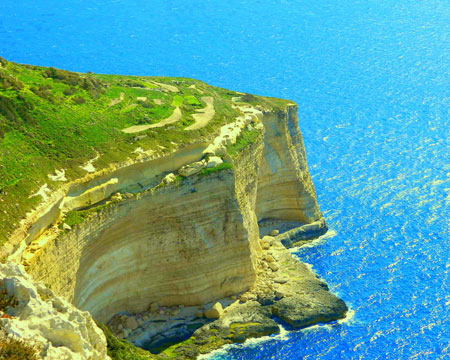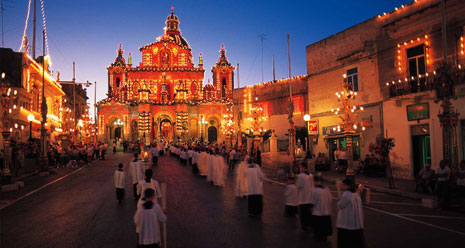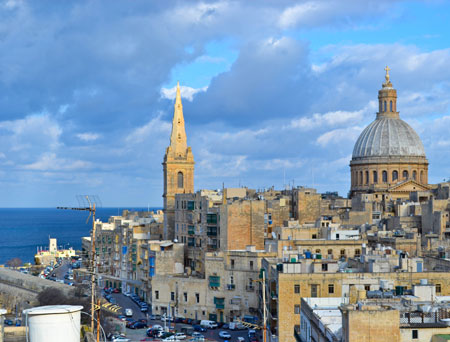Malta
Country statistics

Total area: 124 sq miles (321 sq km)
Population (2010 est.): 406,771 (growth rate: 0.4%); birth rate: 10.3/1000; infant mortality rate: 3.7/1000; life expectancy: 79.6; density per sq km: 1,277
Capital City: Valletta
Monetary unit: Euro
Languages: Maltese and English (both official)
Ethnicity/race: Maltese (descendants of ancient Carthaginians and Phoenicians, with strong elements of Italian and other Mediterranean stock)
Religions: Roman Catholic 98%
Country introduction

Malta is a Southern European country consisting of an archipelago situated in the centre of the Mediterranean, south of Sicily (a region of Italy), east of Tunisia and north of Libya, with Gibraltar to the west and Alexandria (a region of Egypt) to the east. Only the three largest islands, Malta, Gozo (Għawdex), and Comino (Kemmuna) are inhabited.
The topography of the islands consists of a gently undulating limestone plateau. For centuries Malta's abundant limestone has been used for construction, from prehistoric stone monuments to modern-day houses.
There are no mountains, rivers or lakes and the land looks rocky and barren, with the center of the islands dominated by low, flat plains with terraced fields. The barren appearance of the island is emphasized by the scores of dry stonewalls that flank fields, terraces, slopes, gardens and paths. The highest point on Malta is Ta'Dmejrek at 253 m (830 ft), near Dingli. The largest city in Malta is Birkirkara.
The woodlands of Malta were hacked down centuries ago and today the only trees that can be found are the carob, pine, citrus, ficus and tamarisk that have been planted in public parks, along avenues and around town piazzas. On both Malta and Gozo the slopes are cultivated for vegetables and vines.
The heavily indented coastline of Malta and Gozo is predominantly rocky, with only a very occasional sandy bay. The eastern side of the island is broken up by large bays which make ideal natural harbours. To the south spectacular cliffs drop 250 m (820 ft) to the sea. Gozo's coastal scenery is at its most spectacular around the cliffs of Dwejra. Because of its greater quantity of water-retaining blue clay subsoil, Gozo is a greener island than Malta. The lie of the land is different, with villages built on flat-topped hills leaving the slopes for cultivation.
Although there are some small rivers at times of high rainfall, there are no permanent rivers or lakes on Malta. However, some rivers have fresh water running all year round at Baħrija, l-Imtaħleb and San Martin, and at Lunzjata Valley in Gozo.
The culture

The culture of Malta were heavily influenced by the Arabs, the Africans, the French, Italian, Spanish and many others. Despite all the mixture of influences however, those of the Italian and British influences have been the strongest. For example the Maltese Language is the official language of the country, but due to the 150 years of British rule, English became another official language.
Malta is a deeply religious country, with very traditional values and norms. The Catholic Church and Catholicism plays a very important role. In every town or village, at least one church dedicated to a patron saint can be found. Maltese people spend half of the year celebrating their saints, and especially during the summer periods a festa in a town or village is common. During these celebrations, people hang colorful decorations along the streets, statues are adorned in the village square and the skyline at night is colored by the impressive fireworks. The village band also plays a vital role by adding music to the joyful and several stands offer pop corn, confetti, nougat and pastizzi.
Malta is noted for its fine crafts, particularly its handmade lace, hand woven fabrics, blown glass and silver filigree. Folk traditions in music are very strong, and Malta holds a folksong competition every year. The strongest influence on Maltese cuisine is Sicilian, though the popularity of grilled chops and roast and three veg reveals a strong partiality to all things British. Local specialties include pastizzi (savoury cheese pastries), timpana (a macaroni, cheese and egg pie), and fenek (rabbit), which is usually fried or baked in a casserole or pie.
Attractions & landmarks

The beautiful harbor city of Valletta, the capital of Malta, is the most concentrated historic area in the world and a perfectly preserved example of 16th century architecture. While there it is recommended to visit the spectacular St. John's Co-Cathedral, which has brightly lit rooms that are ornately decorated with intricate murals and charming arched ceilings. A couple of other attractions to visit are the Cathedral Museum, the Palace of the Grand Masters, the Upper Barakka Gardens, the Sacra Infermeria, the National Library, and the Manoel Theatre.
Malta has the oldest freestanding structure and the oldest religious structure globally, the Ġgantija Temples. It is thought that the temples were erected during the Neolithic Age (3600 - 2500 BC), which makes them older than the pyramids of Egypt and even the Stonehenge. The temples were possibly the site of a Fertility cult as archeologists believe that the numerous figurines and statues found on site were connected with that cult. According to local Gozitan folklore, a giantess built these temples and used them as places of worship.
There are also other nicely preserved and erect ancient temples scattered among the three major islands. The underground St. Paul and St. Agatha's Catacombs are now a museum displaying numerous Roman, Etruscan and Egyptian artifacts.
The formation of the island has enabled its beaches to be among the summer months hotspots across the Mediterranean. Distinct aquatic events like para-kiting, skiing, surfing and windsurfing can be enjoyed here. The Blue Lagoon inside the virgin island of Comino is probably one of the most well-known beaches on the land. Various restaurants and bars are distributed along the coastlines.